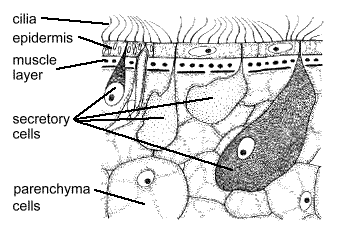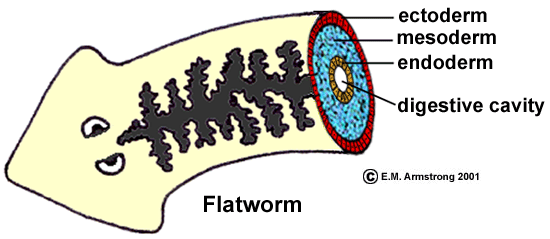Adaptation
 To
adapt to marine life this flatworm uses diffusion to breathe and
to distribute nutrients to other parts of the body. Diffusion is
where elements move from an area of high concentration to an
area of low concentration.
To
adapt to marine life this flatworm uses diffusion to breathe and
to distribute nutrients to other parts of the body. Diffusion is
where elements move from an area of high concentration to an
area of low concentration.
A hydrostatic skeleton makes it easy for flatworms to adapt to aquatic life. It includes fluid held under pressure inside the body.
 The
outermost protection that these flatworms have is called the
epidermis and it contains thousands of cilia (Seifarth, 2002).
Flatworms move in two ways: 1) with their cilia and 2) through the usage
of muscle contractions. Cilia,
tiny, moving bristles, join with muscles under the flatworm's skin
to help them move about. The flatworm uses its muscles
to change the pressure of the fluid in its body (Cambell, 2008).
The
outermost protection that these flatworms have is called the
epidermis and it contains thousands of cilia (Seifarth, 2002).
Flatworms move in two ways: 1) with their cilia and 2) through the usage
of muscle contractions. Cilia,
tiny, moving bristles, join with muscles under the flatworm's skin
to help them move about. The flatworm uses its muscles
to change the pressure of the fluid in its body (Cambell, 2008).
Flatworms are also triploblasts, meaning that there are three cell layers associated with them: the ectoderm (outermost layer), mesoderm (middle layer) and endoderm (innermost layer); (Seifarth, 2002). All of these layers work together to ensure high levels of plasticity for the organism. Plasticity just means how easily something can change shape.
 The
ectoderm houses thousands of cilia while the
mesoderm has secretory cells muscles that regulate
body plasticity. The parenchyma cells inside the mesodermal section
are home to a secretory cells. These cells release mucus through the
flatworm's pores. The mesoderm is lacking a proper coelom, making it an
acoelmate.
The
ectoderm houses thousands of cilia while the
mesoderm has secretory cells muscles that regulate
body plasticity. The parenchyma cells inside the mesodermal section
are home to a secretory cells. These cells release mucus through the
flatworm's pores. The mesoderm is lacking a proper coelom, making it an
acoelmate.